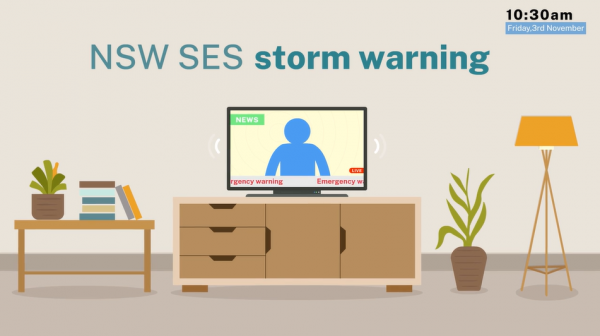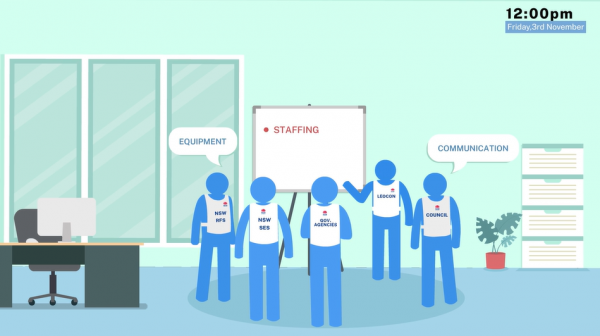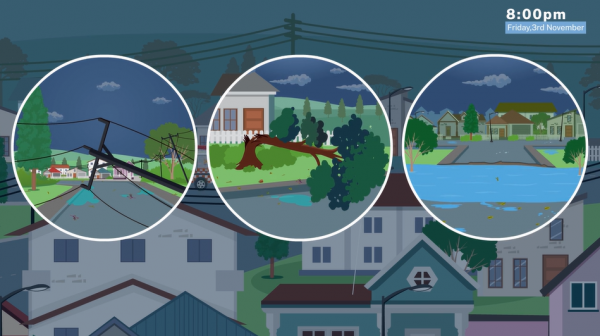Emergency management learning activities
A collection of learning activities demonstrating the NSW emergency management arrangements for various scenarios (more coming soon).
Learning activity – Storm Preparedness
The following video depicts a fictitious scenario where a small rural town, recently impacted by a storm, must again prepare for further forecasted stormy weather.
You can watch the full video below.

At the Town Hall, the local emergency operations controller (LEOCON) gathers with the local emergency management committee for a briefing and discussion about the forecast from the Bureau of Meteorology. Unsettled weather has been predicted for the next few days. Hot and humid conditions mean potential storms and they know that they need to be prepared.
Based on this scenario, what is relevant legislation and plans for storms in NSW?
The two relevant pieces of legislation are the:
- State Emergency and Rescue Management Act 1989 (NSW) (‘SERM Act’ 1989). This gives authority to the NSW State Emergency Management Plan (EMPLAN) and under this the sub plan of the NSW Storm Emergency Sub Plan (NSW State Storm Plan).
- State Emergency Service Act 1989 (NSW) (‘SES Act’ 1989).
Which agency is the combat agency for storms in NSW?
The NSW State Emergency Service is the combat agency for storms in NSW. They are also responsible for developing, reviewing and maintaining the NSW State Storm Plan and associated emergency Sub Plans.
What is a LEOCON and who would they be?
The person appointed must be a police officer stationed within the region in which the local government area is located and, in the opinion of the REOCON, must have experience in emergency management.
If I am part of an LEMC, where can I find the local EMPLAN?
Local EMPLANs can be obtained from the local council.
Regional EMPLANs can be viewed or downloaded here.
The state EMPLAN can be viewed or downloaded here.

The local radio station broadcasts a message from the State Emergency Service, urging residents to take precautions against the forecasted storms. They advise people to secure loose outdoor items, check emergency kits and stay informed about weather updates.
Who is responsible for emergency warnings and associated warning systems?
All levels of government work in partnerships to develop and maintain warning infrastructure.
For storms, NSW SES develops and maintains warning and information products by:
- Utilising intelligence data
- Providing warning products in line with the Australian Warning System (AWS)
- Consulting with affected communities and key stakeholders
- Participating in the development of public information and warning systems

Lunchtime finds the LEOCON meeting with representatives from the Rural Fire Service, State Emergency Service, relevant government agencies and Local Council to review emergency management arrangements and ensure everyone is prepared for potential scenarios. They discuss staffing levels, equipment readiness and communication procedures.
What are some of the actions that are taken to ensure that all relevant stakeholders are prepared for and familiar with the strategies and arrangements within the NSW State Storm plan?
The NSW SES will:
- Consult stakeholders throughout the development and review of plans,
- Train their members and those from other agencies (as requested) to ensure operational readiness
- Conduct evaluations and reviews following all large-scale exercises to identify areas for improvement
- Conduct activities to engage and educate the community
- Ensure their facilities and resources are maintained and operationally ready
- A link to the storm emergency sub plan can be found here.

As dark clouds gather on the horizon, the town activates its public information and emergency warnings arrangements, sending out alerts via text message, email, and social media to keep residents informed about the approaching storm.
The SES Zone Commander, as the Combat Agency for Floods, and the LEOCON encourage everyone to stay indoors and avoid unnecessary travel until the weather passes.
What strategy is implemented to enhance a communities’ resilience to storms?
The NSW SES will collaborate with communities when developing storm information, intelligence, warnings, preparedness, and response information. They will work in partnership with other emergency services, NSW Government, Local Government and community networks to implement a range of programs, activities and initiatives designed to enhance capability, knowledge and skills. More information can be found here.

With the worst of the storm now passed a thorough assessment of the town is performed. Local Council workers, Emergency Services Organisations and Functional Area workers work together to check for damage and to look for hazards such as fallen power lines. While there are reports of fallen trees and localised flooding in some areas, overall, the town has weathered the storm relatively well. Cleanup efforts are already underway, with crews working to clear debris and restore any damage caused by the weather.
What system is used to maintain effective control of storm operations and manage the storm response?
The Australasian Inter-service Incident Management System (AIIMS) is a nationally recognised incident management structure. For more information, click here.